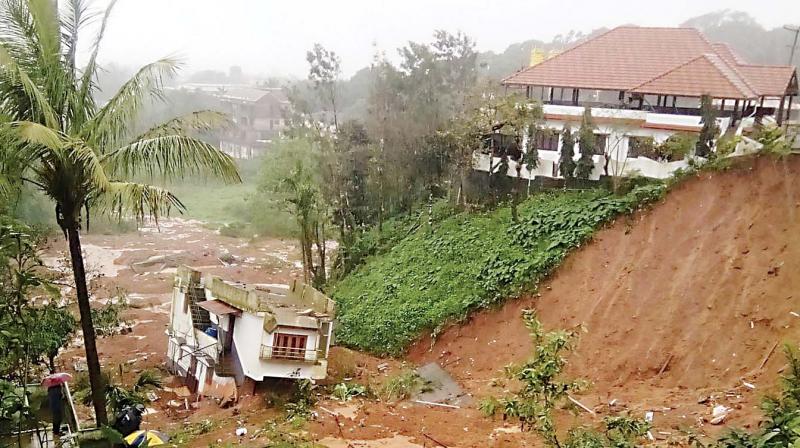Battle ready for the deluge or as vulnerable as ever?
Many had seen the landslides and flooding coming for a long time considering the relentless onslaught on the fragile ecosystem of the Western Ghats.

Kalooru, Makkandur, Madapura, Thanthipala, Devastur, Kalooru Mukkodlu, Monnangeri, Emmethalu, Jodupala, Iggodlu and the Devastur-Somawarpet Road-these are spots etched in the memories of people of the state who could only watch in disbelief as the so familiar green rimmed hills of Kodagu rained havoc on its people forcing them to take shelter in makeshift relief camps set up by the government and community organizations last year.
The government no doubt is on its toes this year to face any eventuality with teams of the NDRF and SDRF arriving much ahead of the onset of the monsoon and conducting mock drills in tough terrain. The big question however remains: have enough lessons been learnt from the calamity? Many had seen the landslides and flooding coming for a long time considering the relentless onslaught on the fragile ecosystem of the Western Ghats. And for this precise reason, one can safely assume that the government has for long failed to take a holistic view of the natural calamity which could happen anywhere in the Western Ghats and not in Kodagu alone.
When the landslide happened in August last, the government soon recovered from its state of shock and started relief work by setting up camps and collecting data on loss of property. As part of the rehabilitation exercise, the district administration has already completed construction of over 450 houses, which are ready to be handed over to the beneficiaries. The repair of roads and other civic structures damaged during the calamity is also almost complete.
On the regulatory front, all kinds of land conversion and large constructions were banned and it is only recently that permission is being issued to build houses in private land measuring five cents.
Revenue Secretary Dr Rajkumar Khatri said the government has plans for all the four districts coming under the eco-sensitive zone of the Western Ghats - Kodagu, Chikkamagaluru, Uttara Kannada and Shivamogga. The idea behind deploying NDRF and SDRF teams in Madikeri and Surathkal is to reach the affected spots speedily in Malnad and the coastal region as swiftly as possible, he said.
The identification of vulnerable areas is a crucial part of any disaster management plan and one cannot help feeling that the government has faltered in this regard. Makkandur in Kodagu crops up during district administration meetings as a vulnerable area but no one knows about the vulnerable areas in the other three districts.
Another problem which seems to have affected the relief efforts are the frequent bureaucratic reshuffles. The Kodagu DCs and ZP CEOs were changed but that has not affected work much. However, when officials like tahsildars and assistant commissioners are transferred, it creates problems for residents.
Says Mr Pradeep of Makkandur, whose brother's house was one of those affected during the landslide, “the tahsildars and ACs keep changing and whenever we go to the taluk office, we have to explain our problems afresh. This has delayed things with even the money for reconstructing the houses arriving just a month ago. Now, the monsoon is about to start and we can't take any chances by starting construction,'' he said.
But the government has acted fast enough when it comes to damaged roads and bridges with the tender norms relaxed o ensure the work began immediately and the PWD completing the job ahead of schedule. “The only problem is that the contractors have used heavy machinery in a fragile area. We don't know how much of pressure it has put on the place again. We will come to know about it only during the monsoon,'' says a resident, P.M. Muthanna.
There are also pleas for slope stabilization before any massive work is taken up. The PWD has prepared concrete retainer walls reinforced with mesh but if there is a landslide again behind these retainer walls, there is no support system for the walls themselves.
“We had suggested growing Vetiver grass for slope stabilization but no one took it seriously. In countries like Malaysia, no vertical cutting is allowed in steep areas without slope stabilization through natural Vetiver grass,” said Thammoo Poovaiah.
Regulating constructions is also none too easy in fragile areas. “The applications of individuals get delayed in taluk offices but those developing layouts in watershed areas like paddy fields manage to get permission which should be stopped immediately,” says Muthanna.
The 'prior sanction' dilemma is another problem the government has to tackle. Soon after the natural calamity, the government banned all land conversions for commercial and tourism purposes. But now, several projects are coming up in extremely fragile areas for which permission was granted prior to the calamity with the district administration watching on helplessly.
Mr Khatri agrees that there could be many issues that have not come to his notice or drawn the attention of the high level committee on disaster management. “Whenever such things come to our notice, we give directions to the respective departments in the committee meeting. It is not just Kodagu, we are concerned about all the four districts, which have eco-sensitive zones. If there are any lapses, they can be rectified,” he said.
Preventing a natural calamity like a deluge may be beyond our control but stopping man-made disasters like the Kodagu landslides is something always possible with a bit of foresight and better planning. Kodagu has always been a paradise for the tourist who can never forget its lush green hills and its fields of rich coffee. And why should a dream retreat for every Kannadiga be turned into a fearful hellhole just because of the relentless pressure of resort and real estate barons, who care two hoots for nature and its pristine wonders?

